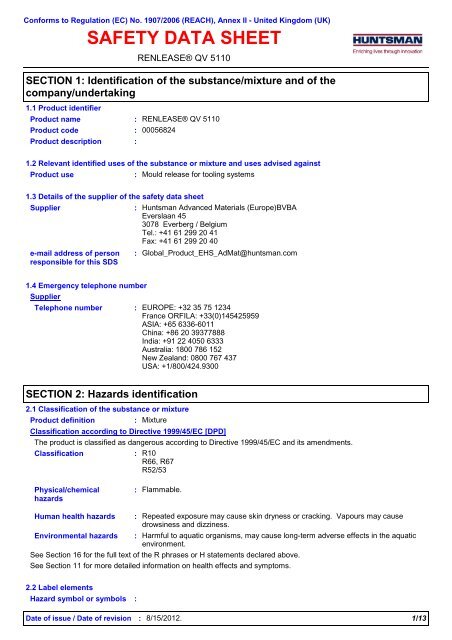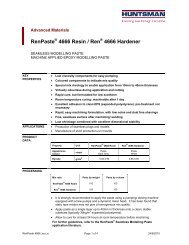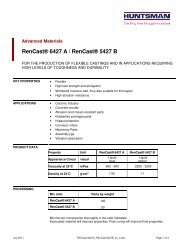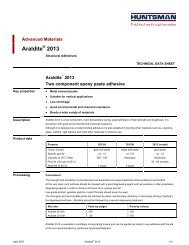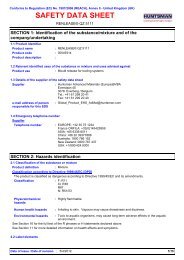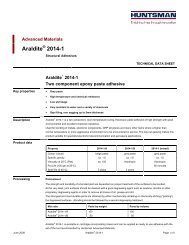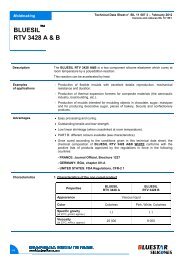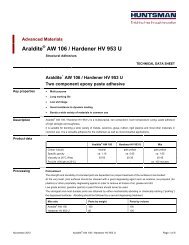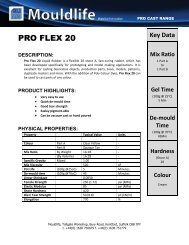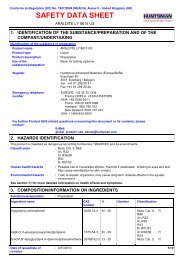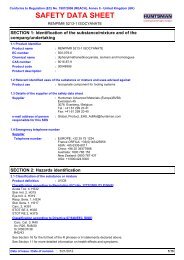View MSDS - Mouldlife
View MSDS - Mouldlife
View MSDS - Mouldlife
Create successful ePaper yourself
Turn your PDF publications into a flip-book with our unique Google optimized e-Paper software.
Conforms to Regulation (EC) No. 1907/2006 (REACH), Annex II - United Kingdom (UK)<br />
SAFETY DATA SHEET<br />
RENLEASE® QV 5110<br />
SECTION 1: Identification of the substance/mixture and of the<br />
company/undertaking<br />
1.1 Product identifier<br />
Product name<br />
: RENLEASE® QV 5110<br />
Product code : 00056824<br />
Product description :<br />
1.2 Relevant identified uses of the substance or mixture and uses advised against<br />
Product use : Mould release for tooling systems<br />
1.3 Details of the supplier of the safety data sheet<br />
Supplier<br />
e-mail address of person<br />
responsible for this SDS<br />
: Huntsman Advanced Materials (Europe)BVBA<br />
Everslaan 45<br />
3078 Everberg / Belgium<br />
Tel.: +41 61 299 20 41<br />
Fax: +41 61 299 20 40<br />
: Global_Product_EHS_AdMat@huntsman.com<br />
1.4 Emergency telephone number<br />
Supplier<br />
Telephone number : EUROPE: +32 35 75 1234<br />
France ORFILA: +33(0)145425959<br />
ASIA: +65 6336-6011<br />
China: +86 20 39377888<br />
India: +91 22 4050 6333<br />
Australia: 1800 786 152<br />
New Zealand: 0800 767 437<br />
USA: +1/800/424.9300<br />
SECTION 2: Hazards identification<br />
2.1 Classification of the substance or mixture<br />
Product definition : Mixture<br />
Classification according to Directive 1999/45/EC [DPD]<br />
The product is classified as dangerous according to Directive 1999/45/EC and its amendments.<br />
Classification<br />
: R10<br />
R66, R67<br />
R52/53<br />
Physical/chemical<br />
hazards<br />
: Flammable.<br />
Human health hazards<br />
:<br />
Repeated exposure may cause skin dryness or cracking. Vapours may cause<br />
drowsiness and dizziness.<br />
Environmental hazards : Harmful to aquatic organisms, may cause long-term adverse effects in the aquatic<br />
environment.<br />
See Section 16 for the full text of the R phrases or H statements declared above.<br />
See Section 11 for more detailed information on health effects and symptoms.<br />
2.2 Label elements<br />
Hazard symbol or symbols :<br />
Date of issue / Date of revision : 8/15/2012.<br />
1/13
Conforms to Regulation (EC) No. 1907/2006 (REACH), Annex II - United Kingdom (UK)<br />
RENLEASE QV 5110<br />
Date of printing :<br />
Date of issue :<br />
15 August 2012<br />
15 August 2012<br />
SECTION 2: Hazards identification<br />
Indication of danger :<br />
Risk phrases<br />
Safety phrases<br />
Hazardous ingredients<br />
Supplemental label<br />
elements<br />
Special packaging requirements<br />
Containers to be fitted<br />
with child-resistant<br />
fastenings<br />
: Not applicable.<br />
Tactile warning of danger<br />
:<br />
:<br />
:<br />
: Not applicable.<br />
:<br />
None.<br />
Not applicable.<br />
<strong>MSDS</strong> no.<br />
Version :<br />
: 00056824<br />
1.01<br />
R10- Flammable.<br />
R66- Repeated exposure may cause skin dryness or cracking.<br />
R67- Vapours may cause drowsiness and dizziness.<br />
R52/53- Harmful to aquatic organisms, may cause long-term adverse effects in the<br />
aquatic environment.<br />
S9- Keep container in a well-ventilated place.<br />
S16- Keep away from sources of ignition - No smoking.<br />
S23- Do not breathe vapour.<br />
S24- Avoid contact with skin.<br />
S29- Do not empty into drains.<br />
S43- In case of fire, never use water.<br />
S61- Avoid release to the environment. Refer to special instructions/safety data<br />
sheet.<br />
Naphtha (petroleum), hydrotreated heavy (benzene
Conforms to Regulation (EC) No. 1907/2006 (REACH), Annex II - United Kingdom (UK)<br />
RENLEASE QV 5110<br />
Date of printing : 15 August 2012<br />
<strong>MSDS</strong> no.<br />
: 00056824<br />
Date of issue : 15 August 2012<br />
Version : 1.01<br />
3/13<br />
SECTION 3: Composition/information on ingredients<br />
See Section 16 for<br />
the full text of the R-<br />
phrases declared<br />
above.<br />
See Section 16 for the<br />
full text of the H<br />
statements declared<br />
above.<br />
There are no additional ingredients present which, within the current knowledge of the supplier and in the<br />
concentrations applicable, are classified as hazardous to health or the environment and hence require reporting in this<br />
section.<br />
Type<br />
[1] Substance classified with a health or environmental hazard<br />
[2] Substance with a workplace exposure limit<br />
[3] Substance meets the criteria for PBT according to Regulation (EC) No. 1907/2006, Annex XIII<br />
[4] Substance meets the criteria for vPvB according to Regulation (EC) No. 1907/2006, Annex XIII<br />
Occupational exposure limits, if available, are listed in Section 8.<br />
SECTION 4: First aid measures<br />
4.1 Description of first aid measures<br />
Eye contact<br />
: Immediately flush eyes with plenty of water, occasionally lifting the upper and lower<br />
eyelids. Check for and remove any contact lenses. Continue to rinse for at least 10<br />
minutes. Get medical attention.<br />
Inhalation<br />
:<br />
Remove victim to fresh air and keep at rest in a position comfortable for breathing. If<br />
it is suspected that fumes are still present, the rescuer should wear an appropriate<br />
mask or self-contained breathing apparatus. If not breathing, if breathing is irregular<br />
or if respiratory arrest occurs, provide artificial respiration or oxygen by trained<br />
personnel. It may be dangerous to the person providing aid to give mouth-to-mouth<br />
resuscitation. Get medical attention. If unconscious, place in recovery position and<br />
get medical attention immediately. Maintain an open airway. Loosen tight clothing<br />
such as a collar, tie, belt or waistband.<br />
Skin contact<br />
Ingestion<br />
:<br />
:<br />
Wash skin thoroughly with soap and water or use recognised skin cleanser.<br />
Remove contaminated clothing and shoes. Get medical attention if symptoms occur.<br />
Wash clothing before reuse. Clean shoes thoroughly before reuse.<br />
Wash out mouth with water. Remove dentures if any. Remove victim to fresh air<br />
and keep at rest in a position comfortable for breathing. If material has been<br />
swallowed and the exposed person is conscious, give small quantities of water to<br />
drink. Stop if the exposed person feels sick as vomiting may be dangerous. Do not<br />
induce vomiting unless directed to do so by medical personnel. If vomiting occurs,<br />
the head should be kept low so that vomit does not enter the lungs. Get medical<br />
attention if adverse health effects persist or are severe. Never give anything by<br />
mouth to an unconscious person. If unconscious, place in recovery position and get<br />
medical attention immediately. Maintain an open airway. Loosen tight clothing such<br />
as a collar, tie, belt or waistband.<br />
Protection of first-aiders<br />
: No action shall be taken involving any personal risk or without suitable training. It<br />
may be dangerous to the person providing aid to give mouth-to-mouth resuscitation.<br />
4.2 Most important symptoms and effects, both acute and delayed<br />
Potential acute health effects<br />
Eye contact<br />
: May cause eye irritation.<br />
Inhalation<br />
: Vapours may cause drowsiness and dizziness.<br />
Skin contact<br />
: Defatting to the skin. May cause skin dryness and irritation.<br />
Ingestion<br />
: No known significant effects or critical hazards.<br />
Over-exposure signs/symptoms<br />
Eye contact<br />
: No specific data.<br />
Date of issue / Date of revision : 8/15/2012.<br />
3/13
Conforms to Regulation (EC) No. 1907/2006 (REACH), Annex II - United Kingdom (UK)<br />
RENLEASE QV 5110<br />
Date of printing : 15 August 2012<br />
<strong>MSDS</strong> no.<br />
: 00056824<br />
Date of issue : 15 August 2012<br />
Version : 1.01<br />
4/13<br />
SECTION 4: First aid measures<br />
Inhalation<br />
Skin contact<br />
Ingestion<br />
:<br />
:<br />
:<br />
Adverse symptoms may include the following:<br />
nausea or vomiting<br />
headache<br />
drowsiness/fatigue<br />
dizziness/vertigo<br />
Adverse symptoms may include the following:<br />
irritation<br />
dryness<br />
cracking<br />
No specific data.<br />
4.3 Indication of any immediate medical attention and special treatment needed<br />
Notes to physician : Treat symptomatically. Contact poison treatment specialist immediately if large<br />
quantities have been ingested or inhaled.<br />
Specific treatments<br />
: Symptomatic treatment and supportive therapy as indicated. Following severe<br />
exposure the patient should be kept under medical review for at least 48 hours.<br />
SECTION 5: Firefighting measures<br />
5.1 Extinguishing media<br />
Suitable extinguishing<br />
media<br />
Unsuitable extinguishing<br />
media<br />
:<br />
:<br />
Use dry chemical, CO2, water spray (fog) or foam.<br />
Do not use water jet.<br />
5.2 Special hazards arising from the substance or mixture<br />
Hazards from the<br />
substance or mixture<br />
Hazardous thermal<br />
decomposition products<br />
:<br />
:<br />
Flammable liquid. In a fire or if heated, a pressure increase will occur and the<br />
container may burst, with the risk of a subsequent explosion. Runoff to sewer may<br />
create fire or explosion hazard.<br />
No specific data.<br />
5.3 Advice for firefighters<br />
Special precautions for<br />
fire-fighters<br />
Special protective<br />
equipment for fire-fighters<br />
:<br />
:<br />
Promptly isolate the scene by removing all persons from the vicinity of the incident if<br />
there is a fire. No action shall be taken involving any personal risk or without suitable<br />
training. Move containers from fire area if this can be done without risk. Use water<br />
spray to keep fire-exposed containers cool. This material is harmful to aquatic<br />
organisms. Fire water contaminated with this material must be contained and<br />
prevented from being discharged to any waterway, sewer or drain.<br />
Fire-fighters should wear appropriate protective equipment and self-contained<br />
breathing apparatus (SCBA) with a full face-piece operated in positive pressure<br />
mode. Clothing for fire-fighters (including helmets, protective boots and gloves)<br />
conforming to European standard EN 469 will provide a basic level of protection for<br />
chemical incidents.<br />
SECTION 6: Accidental release measures<br />
6.1 Personal precautions, protective equipment and emergency procedures<br />
For non-emergency<br />
personnel<br />
: No action shall be taken involving any personal risk or without suitable training.<br />
Evacuate surrounding areas. Keep unnecessary and unprotected personnel from<br />
entering. Do not touch or walk through spilt material. Shut off all ignition sources.<br />
No flares, smoking or flames in hazard area. Avoid breathing vapour or mist.<br />
Provide adequate ventilation. Wear appropriate respirator when ventilation is<br />
inadequate. Put on appropriate personal protective equipment.<br />
Date of issue / Date of revision : 8/15/2012.<br />
4/13
Conforms to Regulation (EC) No. 1907/2006 (REACH), Annex II - United Kingdom (UK)<br />
RENLEASE QV 5110<br />
Date of printing : 15 August 2012<br />
<strong>MSDS</strong> no.<br />
: 00056824<br />
Date of issue : 15 August 2012<br />
Version : 1.01<br />
5/13<br />
SECTION 6: Accidental release measures<br />
For emergency responders :<br />
If specialised clothing is required to deal with the spillage, take note of any<br />
information in Section 8 on suitable and unsuitable materials. See also Section 8 for<br />
additional information on hygiene measures.<br />
6.2 Environmental<br />
precautions<br />
:<br />
Avoid dispersal of spilt material and runoff and contact with soil, waterways, drains<br />
and sewers. Inform the relevant authorities if the product has caused environmental<br />
pollution (sewers, waterways, soil or air). Water polluting material.<br />
6.3 Methods and materials for containment and cleaning up<br />
Small spill :<br />
Large spill :<br />
Stop leak if without risk. Move containers from spill area. Dilute with water and mop<br />
up if water-soluble. Alternatively, or if water-insoluble, absorb with an inert dry<br />
material and place in an appropriate waste disposal container. Use spark-proof tools<br />
and explosion-proof equipment. Dispose of via a licensed waste disposal contractor.<br />
Stop leak if without risk. Move containers from spill area. Approach the release<br />
from upwind. Prevent entry into sewers, water courses, basements or confined<br />
areas. Wash spillages into an effluent treatment plant or proceed as follows.<br />
Contain and collect spillage with non-combustible, absorbent material e.g. sand,<br />
earth, vermiculite or diatomaceous earth and place in container for disposal<br />
according to local regulations. Use spark-proof tools and explosion-proof<br />
equipment. Dispose of via a licensed waste disposal contractor. Contaminated<br />
absorbent material may pose the same hazard as the spilt product.<br />
6.4 Reference to other<br />
sections<br />
:<br />
See Section 1 for emergency contact information.<br />
See Section 8 for information on appropriate personal protective equipment.<br />
See Section 13 for additional waste treatment information.<br />
SECTION 7: Handling and storage<br />
The information in this section contains generic advice and guidance. The list of Identified Uses in Section 1 should be<br />
consulted for any available use-specific information provided in the Exposure Scenario(s).<br />
7.1 Precautions for safe handling<br />
Protective measures : Put on appropriate personal protective equipment (see Section 8). Do not ingest.<br />
Avoid contact with eyes, skin and clothing. Avoid breathing vapour or mist. Use only<br />
with adequate ventilation. Wear appropriate respirator when ventilation is<br />
inadequate. Do not enter storage areas and confined spaces unless adequately<br />
ventilated. Keep in the original container or an approved alternative made from a<br />
compatible material, kept tightly closed when not in use. Store and use away from<br />
heat, sparks, open flame or any other ignition source. Use explosion-proof electrical<br />
(ventilating, lighting and material handling) equipment. Use non-sparking tools.<br />
Take precautionary measures against electrostatic discharges. To avoid fire or<br />
explosion, dissipate static electricity during transfer by earthing and bonding<br />
containers and equipment before transferring material. Empty containers retain<br />
product residue and can be hazardous. Do not reuse container.<br />
Advice on general<br />
occupational hygiene<br />
:<br />
Not applicable.<br />
Eating, drinking and smoking should be prohibited in areas where this material is<br />
handled, stored and processed. Workers should wash hands and face before<br />
eating, drinking and smoking. Remove contaminated clothing and protective<br />
equipment before entering eating areas. See also Section 8 for additional<br />
information on hygiene measures.<br />
Date of issue / Date of revision : 8/15/2012.<br />
5/13
Conforms to Regulation (EC) No. 1907/2006 (REACH), Annex II - United Kingdom (UK)<br />
RENLEASE QV 5110<br />
Date of printing : 15 August 2012<br />
<strong>MSDS</strong> no.<br />
: 00056824<br />
Date of issue : 15 August 2012<br />
Version : 1.01<br />
6/13<br />
SECTION 7: Handling and storage<br />
7.2 Conditions for safe<br />
storage, including any<br />
incompatibilities<br />
:<br />
Store between the following temperatures: 2 to 40°C (35.6 to 104°F). Store in<br />
accordance with local regulations. Store in a segregated and approved area. Store<br />
in original container protected from direct sunlight in a dry, cool and well-ventilated<br />
area, away from incompatible materials (see section 10) and food and drink.<br />
Eliminate all ignition sources. Separate from oxidizing materials. Keep container<br />
tightly closed and sealed until ready for use. Containers that have been opened<br />
must be carefully resealed and kept upright to prevent leakage. Do not store in<br />
unlabelled containers. Use appropriate containment to avoid environmental<br />
contamination.<br />
Storage hazard class<br />
Huntsman Advanced<br />
Materials<br />
: Storage class 4, Flammable solid substances<br />
7.3 Specific end use(s)<br />
Recommendations :<br />
Industrial sector specific<br />
solutions<br />
:<br />
Not available.<br />
Not available.<br />
SECTION 8: Exposure controls/personal protection<br />
The information in this section contains generic advice and guidance. The list of Identified Uses in Section 1 should be<br />
consulted for any available use-specific information provided in the Exposure Scenario(s).<br />
8.1 Control parameters<br />
Occupational exposure limits<br />
No exposure limit value known.<br />
Recommended monitoring<br />
procedures<br />
Derived effect levels<br />
No DELs available.<br />
:<br />
If this product contains ingredients with exposure limits, personal, workplace<br />
atmosphere or biological monitoring may be required to determine the effectiveness<br />
of the ventilation or other control measures and/or the necessity to use respiratory<br />
protective equipment. Reference should be made to European Standard EN 689 for<br />
methods for the assessment of exposure by inhalation to chemical agents and<br />
national guidance documents for methods for the determination of hazardous<br />
substances.<br />
Predicted effect concentrations<br />
No PECs available.<br />
8.2 Exposure controls<br />
Appropriate engineering<br />
controls<br />
Individual protection measures<br />
Hygiene measures :<br />
Eye/face protection :<br />
Skin protection<br />
: Use only with adequate ventilation. Use process enclosures, local exhaust<br />
ventilation or other engineering controls to keep worker exposure to airborne<br />
contaminants below any recommended or statutory limits. The engineering controls<br />
also need to keep gas, vapour or dust concentrations below any lower explosive<br />
limits. Use explosion-proof ventilation equipment.<br />
Wash hands, forearms and face thoroughly after handling chemical products, before<br />
eating, smoking and using the lavatory and at the end of the working period.<br />
Appropriate techniques should be used to remove potentially contaminated clothing.<br />
Wash contaminated clothing before reusing. Ensure that eyewash stations and<br />
safety showers are close to the workstation location.<br />
Safety eyewear complying with an approved standard should be used when a risk<br />
assessment indicates this is necessary to avoid exposure to liquid splashes, mists<br />
or dusts.<br />
Date of issue / Date of revision : 8/15/2012.<br />
6/13
Conforms to Regulation (EC) No. 1907/2006 (REACH), Annex II - United Kingdom (UK)<br />
RENLEASE QV 5110<br />
Date of printing :<br />
Date of issue :<br />
15 August 2012<br />
15 August 2012<br />
<strong>MSDS</strong> no.<br />
SECTION 8: Exposure controls/personal protection<br />
Hand protection<br />
Material of gloves for<br />
long term application<br />
(BTT>480min):<br />
Material of gloves for<br />
short term/splash<br />
application<br />
(10min24°C [DIN 51755: Abel-Pensky]<br />
Not available.<br />
: Not available.<br />
: Not applicable.<br />
: Not applicable.<br />
: Lower: 0.6%<br />
Upper: 7%<br />
Conforms to Regulation (EC) No. 1907/2006 (REACH), Annex II - United Kingdom (UK)<br />
RENLEASE QV 5110<br />
Date of printing : 15 August 2012<br />
<strong>MSDS</strong> no.<br />
: 00056824<br />
Date of issue : 15 August 2012<br />
Version : 1.01<br />
SECTION 9: Physical and chemical properties<br />
Water solubility : 20 deg C<br />
8/13<br />
Partition coefficient: n-<br />
octanol/water (LogKow)<br />
Not available.<br />
Auto-ignition temperature : >200°C<br />
Decomposition temperature : Not available.<br />
Viscosity<br />
: Not available.<br />
Explosive properties<br />
: Not available.<br />
Oxidising properties : Not available.<br />
:<br />
9.2 Other information<br />
Density<br />
: 0.8 g/cm 3 [20°C (68°F)]<br />
Softening point : > 30 deg C<br />
SECTION 10: Stability and reactivity<br />
10.1 Reactivity : No specific test data related to reactivity available for this product or its ingredients.<br />
10.2 Chemical stability :<br />
The product is stable.<br />
10.3 Possibility of<br />
hazardous reactions<br />
: Under normal conditions of storage and use, hazardous reactions will not occur.<br />
10.4 Conditions to avoid : Avoid all possible sources of ignition (spark or flame). Do not pressurise, cut, weld,<br />
braze, solder, drill, grind or expose containers to heat or sources of ignition.<br />
10.5 Incompatible materials :<br />
strong acids, strong bases, strong oxidising agents<br />
10.6 Hazardous<br />
decomposition products<br />
SECTION 11: Toxicological information<br />
11.1 Information on toxicological effects<br />
Acute toxicity<br />
Irritation/Corrosion<br />
Conclusion/Summary<br />
Skin :<br />
Eyes :<br />
Respiratory :<br />
Sensitiser<br />
Conclusion/Summary<br />
Mutagenicity<br />
Carcinogenicity<br />
Reproductive toxicity<br />
Teratogenicity<br />
:<br />
Under normal conditions of storage and use, hazardous decomposition products<br />
should not be produced.<br />
Decomposition products may include the following materials:Burning produces<br />
obnoxious and toxic fumes., Carbon oxides<br />
No additional information.<br />
No additional information.<br />
No additional information.<br />
: No additional information.<br />
Date of issue / Date of revision : 8/15/2012.<br />
8/13
Conforms to Regulation (EC) No. 1907/2006 (REACH), Annex II - United Kingdom (UK)<br />
RENLEASE QV 5110<br />
Date of printing : 15 August 2012<br />
<strong>MSDS</strong> no.<br />
: 00056824<br />
Date of issue : 15 August 2012<br />
Version : 1.01<br />
9/13<br />
SECTION 11: Toxicological information<br />
Information on the likely<br />
routes of exposure<br />
Potential acute health effects<br />
Inhalation<br />
Ingestion<br />
Skin contact<br />
Eye contact<br />
: Vapours may cause drowsiness and dizziness.<br />
: No known significant effects or critical hazards.<br />
: Defatting to the skin. May cause skin dryness and irritation.<br />
: May cause eye irritation.<br />
Symptoms related to the physical, chemical and toxicological characteristics<br />
Inhalation<br />
: Adverse symptoms may include the following:<br />
nausea or vomiting<br />
headache<br />
drowsiness/fatigue<br />
dizziness/vertigo<br />
Ingestion<br />
Skin contact<br />
:<br />
:<br />
:<br />
Not available.<br />
No specific data.<br />
Adverse symptoms may include the following:<br />
irritation<br />
dryness<br />
cracking<br />
Eye contact<br />
: No specific data.<br />
Delayed and immediate effects and also chronic effects from short and long term exposure<br />
Short term exposure<br />
Potential immediate<br />
effects<br />
:<br />
Not available.<br />
Potential delayed effects :<br />
Long term exposure<br />
Potential immediate<br />
effects<br />
:<br />
Not available.<br />
Not available.<br />
Potential delayed effects :<br />
Not available.<br />
Potential chronic health effects<br />
Conclusion/Summary : Not available.<br />
General : Prolonged or repeated contact can defat the skin and lead to irritation, cracking<br />
and/or dermatitis.<br />
Carcinogenicity : No known significant effects or critical hazards.<br />
Mutagenicity : No known significant effects or critical hazards.<br />
Teratogenicity : No known significant effects or critical hazards.<br />
Developmental effects : No known significant effects or critical hazards.<br />
Fertility effects<br />
: No known significant effects or critical hazards.<br />
Other information : Not available.<br />
SECTION 12: Ecological information<br />
12.1 Toxicity<br />
12.2 Persistence and degradability<br />
12.3 Bioaccumulative potential<br />
Not available.<br />
12.4 Mobility in soil<br />
Date of issue / Date of revision : 8/15/2012.<br />
9/13
Conforms to Regulation (EC) No. 1907/2006 (REACH), Annex II - United Kingdom (UK)<br />
RENLEASE QV 5110<br />
Date of printing : 15 August 2012<br />
<strong>MSDS</strong> no.<br />
: 00056824<br />
Date of issue : 15 August 2012<br />
Version : 1.01<br />
10/13<br />
SECTION 12: Ecological information<br />
Soil/water partition<br />
coefficient (KOC)<br />
Mobility<br />
:<br />
:<br />
Not available.<br />
Not available.<br />
12.5 Results of PBT and vPvB assessment<br />
Not applicable.<br />
12.6 Other adverse effects : No known significant effects or critical hazards.<br />
12.7 Other ecological information<br />
SECTION 13: Disposal considerations<br />
The information in this section contains generic advice and guidance. The list of Identified Uses in Section 1 should be<br />
consulted for any available use-specific information provided in the Exposure Scenario(s).<br />
13.1 Waste treatment methods<br />
Product<br />
Methods of disposal<br />
:<br />
The generation of waste should be avoided or minimised wherever possible.<br />
Significant quantities of waste product residues should not be disposed of via the<br />
foul sewer but processed in a suitable effluent treatment plant. Dispose of surplus<br />
and non-recyclable products via a licensed waste disposal contractor. Disposal of<br />
this product, solutions and any by-products should at all times comply with the<br />
requirements of environmental protection and waste disposal legislation and any<br />
regional local authority requirements. Waste packaging should be recycled.<br />
Incineration or landfill should only be considered when recycling is not feasible. This<br />
material and its container must be disposed of in a safe way. Care should be taken<br />
when handling emptied containers that have not been cleaned or rinsed out. Empty<br />
containers or liners may retain some product residues. Vapor from product residues<br />
may create a highly flammable or explosive atmosphere inside the container. Do not<br />
cut, weld or grind used containers unless they have been cleaned thoroughly<br />
internally. Avoid dispersal of spilt material and runoff and contact with soil,<br />
waterways, drains and sewers.<br />
Hazardous waste : Yes.<br />
European waste catalogue (EWC)<br />
Waste code<br />
Waste designation<br />
07 02 04* other organic solvents, washing liquids and mother liquors<br />
Packaging<br />
Methods of disposal :<br />
Special precautions :<br />
The generation of waste should be avoided or minimised wherever possible. Waste<br />
packaging should be recycled. Incineration or landfill should only be considered<br />
when recycling is not feasible.<br />
This material and its container must be disposed of in a safe way. Care should be<br />
taken when handling emptied containers that have not been cleaned or rinsed out.<br />
Empty containers or liners may retain some product residues. Vapor from product<br />
residues may create a highly flammable or explosive atmosphere inside the<br />
container. Do not cut, weld or grind used containers unless they have been cleaned<br />
thoroughly internally. Avoid dispersal of spilt material and runoff and contact with<br />
soil, waterways, drains and sewers.<br />
Date of issue / Date of revision : 8/15/2012.<br />
10/13
Conforms to Regulation (EC) No. 1907/2006 (REACH), Annex II - United Kingdom (UK)<br />
RENLEASE QV 5110<br />
Date of printing : 15 August 2012<br />
<strong>MSDS</strong> no.<br />
: 00056824<br />
Date of issue : 15 August 2012<br />
Version : 1.01<br />
11/13<br />
SECTION 14: Transport information<br />
14.1 UN number 14.2 UN proper shipping name<br />
ADR/RID<br />
IMDG<br />
IATA<br />
UN3175<br />
UN3175<br />
UN3175<br />
Solids containing flammable liquid, n.o.s. PETROLEUM,<br />
ALIPHATIC/AROMATIC<br />
Solids containing flammable liquid, n.o.s. (PETROLEUM,<br />
ALIPHATIC/AROMATIC)<br />
Solids containing flammable liquid, n.o.s. (PETROLEUM,<br />
ALIPHATIC/AROMATIC)<br />
14.3 Transport<br />
hazard class(es)<br />
14.4 Packing<br />
group<br />
14.5<br />
Environmental<br />
hazards<br />
14.6 Special<br />
precautions for<br />
user<br />
Additional<br />
information<br />
ADR/RID<br />
4.1 II<br />
No.<br />
Not available.<br />
Hazard<br />
identification<br />
number<br />
40<br />
Special<br />
provisions<br />
216 274<br />
Tunnel code<br />
E<br />
IMDG<br />
4.1 II<br />
No.<br />
Not available.<br />
Emergency<br />
schedules (EmS)<br />
F-A, S-I<br />
IATA<br />
4.1 II<br />
No.<br />
Not available.<br />
Passenger and<br />
Cargo Aircraft<br />
Quantity limitation:<br />
15 kg<br />
Packaging<br />
instructions: 445<br />
Cargo Aircraft<br />
OnlyQuantity<br />
limitation: 50 kg<br />
Packaging<br />
instructions: 448<br />
14.7 Transport in bulk<br />
according to Annex II of<br />
MARPOL 73/78 and the IBC<br />
Code<br />
: Not applicable.<br />
SECTION 15: Regulatory information<br />
15.1 Safety, health and environmental regulations/legislation specific for the substance or mixture<br />
EU Regulation (EC) No. 1907/2006 (REACH)<br />
Annex XIV - List of substances subject to authorisation<br />
Substances of very high concern<br />
None of the components are listed.<br />
Date of issue / Date of revision : 8/15/2012.<br />
11/13
Conforms to Regulation (EC) No. 1907/2006 (REACH), Annex II - United Kingdom (UK)<br />
RENLEASE QV 5110<br />
Date of printing :<br />
Date of issue :<br />
15 August 2012<br />
15 August 2012<br />
SECTION 15: Regulatory information<br />
Annex XVII - Restrictions<br />
on the manufacture,<br />
placing on the market and<br />
use of certain dangerous<br />
substances, mixtures and<br />
articles<br />
Other EU regulations<br />
Europe inventory<br />
Black List Chemicals<br />
Priority List Chemicals<br />
Integrated pollution<br />
prevention and control<br />
list (IPPC) - Air<br />
Integrated pollution<br />
prevention and control<br />
list (IPPC) - Water<br />
National regulations<br />
References<br />
International regulations<br />
Chemical Weapons<br />
Convention List Schedule I<br />
Chemicals<br />
:<br />
Not applicable.<br />
<strong>MSDS</strong> no.<br />
: All components are listed or exempted.<br />
: Not listed<br />
: Not listed<br />
: Not listed<br />
: Not listed<br />
: Not listed<br />
Version :<br />
: 00056824<br />
1.01<br />
12/13<br />
: The provision of Safety Data Sheets comes under Regulation 6 of CHIP (CHIP is the<br />
recognised abbreviation for the Chemicals Hazard Information and Packaging<br />
Regulations). This is an addition to the Health and Safety at Work Act 1974.<br />
Chemical Weapons<br />
Convention List Schedule II<br />
Chemicals<br />
Chemical Weapons<br />
Convention List Schedule III<br />
Chemicals<br />
: Not listed<br />
: Not listed<br />
15.2 Chemical Safety<br />
Assessment<br />
SECTION 16: Other information<br />
:<br />
This product contains substances for which Chemical Safety Assessments are still<br />
required.<br />
Indicates information that has changed from previously issued version.<br />
Abbreviations and<br />
acronyms<br />
: ATE = Acute Toxicity Estimate<br />
CLP = Classification, Labelling and Packaging Regulation [Regulation (EC) No.<br />
1272/2008]<br />
DNEL = Derived No Effect Level<br />
EUH statement = CLP-specific Hazard statement<br />
PNEC = Predicted No Effect Concentration<br />
RRN = REACH Registration Number<br />
Classification according to Regulation (EC) No. 1272/2008 [CLP/GHS]<br />
Flam. Liq. 3, H226<br />
STOT SE 3, H336<br />
Aquatic Chronic 3, H412<br />
Procedure used to derive the classification according to Regulation (EC) No. 1272/2008 [CLP/GHS]<br />
Flam. Liq. 3, H226<br />
STOT SE 3, H336<br />
Aquatic Chronic 3, H412<br />
Classification<br />
On basis of test data<br />
Calculation method<br />
Calculation method<br />
Justification<br />
Date of issue / Date of revision : 8/15/2012.<br />
12/13
Conforms to Regulation (EC) No. 1907/2006 (REACH), Annex II - United Kingdom (UK)<br />
RENLEASE QV 5110<br />
Date of printing :<br />
Date of issue :<br />
15 August 2012<br />
15 August 2012<br />
SECTION 16: Other information<br />
Full text of abbreviated H<br />
statements<br />
Full text of classifications<br />
[CLP/GHS]<br />
Full text of abbreviated R<br />
phrases<br />
Full text of classifications<br />
[DSD/DPD]<br />
<strong>MSDS</strong> no. : 00056824<br />
Date of printing<br />
Date of issue/ Date of<br />
revision<br />
Date of previous issue<br />
Version<br />
Notice to reader<br />
:<br />
:<br />
:<br />
:<br />
:<br />
8/15/2012.<br />
<strong>MSDS</strong> no.<br />
Xn - Harmful<br />
N - Dangerous for the environment<br />
8/15/2012.<br />
2/2/2011.<br />
1.01<br />
Version :<br />
: 00056824<br />
1.01<br />
13/13<br />
: H226 Flammable liquid and vapour.<br />
H304 May be fatal if swallowed and enters airways.<br />
H336 May cause drowsiness or dizziness.<br />
H411 Toxic to aquatic life with long lasting effects.<br />
H412 Harmful to aquatic life with long lasting effects.<br />
: Aquatic Chronic 2, H411 AQUATIC TOXICITY (CHRONIC) - Category 2<br />
Aquatic Chronic 3, H412 AQUATIC TOXICITY (CHRONIC) - Category 3<br />
Asp. Tox. 1, H304 ASPIRATION HAZARD - Category 1<br />
Flam. Liq. 3, H226 FLAMMABLE LIQUIDS - Category 3<br />
STOT SE 3, H336 SPECIFIC TARGET ORGAN TOXICITY (SINGLE<br />
EXPOSURE) [Narcotic effects] - Category 3<br />
: R10- Flammable.<br />
R65- Harmful: may cause lung damage if swallowed.<br />
R66- Repeated exposure may cause skin dryness or cracking.<br />
R67- Vapours may cause drowsiness and dizziness.<br />
R51/53- Toxic to aquatic organisms, may cause long-term adverse effects in the<br />
aquatic environment.<br />
R52/53- Harmful to aquatic organisms, may cause long-term adverse effects in the<br />
aquatic environment.<br />
While the information and recommendations in this publication are to the best of our knowledge, information<br />
and belief accurate at the date of publication, NOTHING HEREIN IS TO BE CONSTRUED AS A WARRANTY,<br />
EXPRESS OR OTHERWISE.<br />
IN ALL CASES, IT IS THE RESPONSIBILITY OF THE USER TO DETERMINE THE APPLICABILITY OF SUCH<br />
INFORMATION AND RECOMMENDATIONS AND THE SUITABILITY OF ANY PRODUCT FOR ITS OWN<br />
PARTICULAR PURPOSE.<br />
THE PRODUCT MAY PRESENT HAZARDS AND SHOULD BE USED WITH CAUTION. WHILE CERTAIN HAZARDS<br />
ARE DESCRIBED IN THIS PUBLICATION, NO GUARANTEE IS MADE THAT THESE ARE THE ONLY HAZARDS<br />
THAT EXIST.<br />
Hazards, toxicity and behaviour of the products may differ when used with other materials and are dependent<br />
upon the manufacturing circumstances or other processes. Such hazards, toxicity and behaviour should be<br />
determined by the user and made known to handlers, processors and end users.<br />
RENLEASE® is a registered trademark of Huntsman Corporation or an affiliate thereof in one or more<br />
countries, but not all countries.<br />
NO PERSON OR ORGANIZATION EXCEPT A DULY AUTHORIZED HUNTSMAN EMPLOYEE IS AUTHORIZED TO<br />
PROVIDE OR MAKE AVAILABLE DATA SHEETS FOR HUNTSMAN PRODUCTS. DATA SHEETS FROM<br />
UNAUTHORIZED SOURCES MAY CONTAIN INFORMATION THAT IS NO LONGER CURRENT OR ACCURATE.<br />
NO PART OF THIS DATA SHEET MAY BE REPRODUCED OR TRANSMITTED IN ANY FORM, OR BY ANY<br />
MEANS, WITHOUT PERMISSION IN WRITING FROM HUNTSMAN. ALL REQUESTS FOR PERMISSION TO<br />
REPRODUCE MATERIAL FROM THIS DATA SHEET SHOULD BE DIRECTED TO HUNTSMAN, MANAGER,<br />
PRODUCT SAFETY AT THE ABOVE ADDRESS.<br />
Date of issue / Date of revision : 8/15/2012.<br />
13/13


